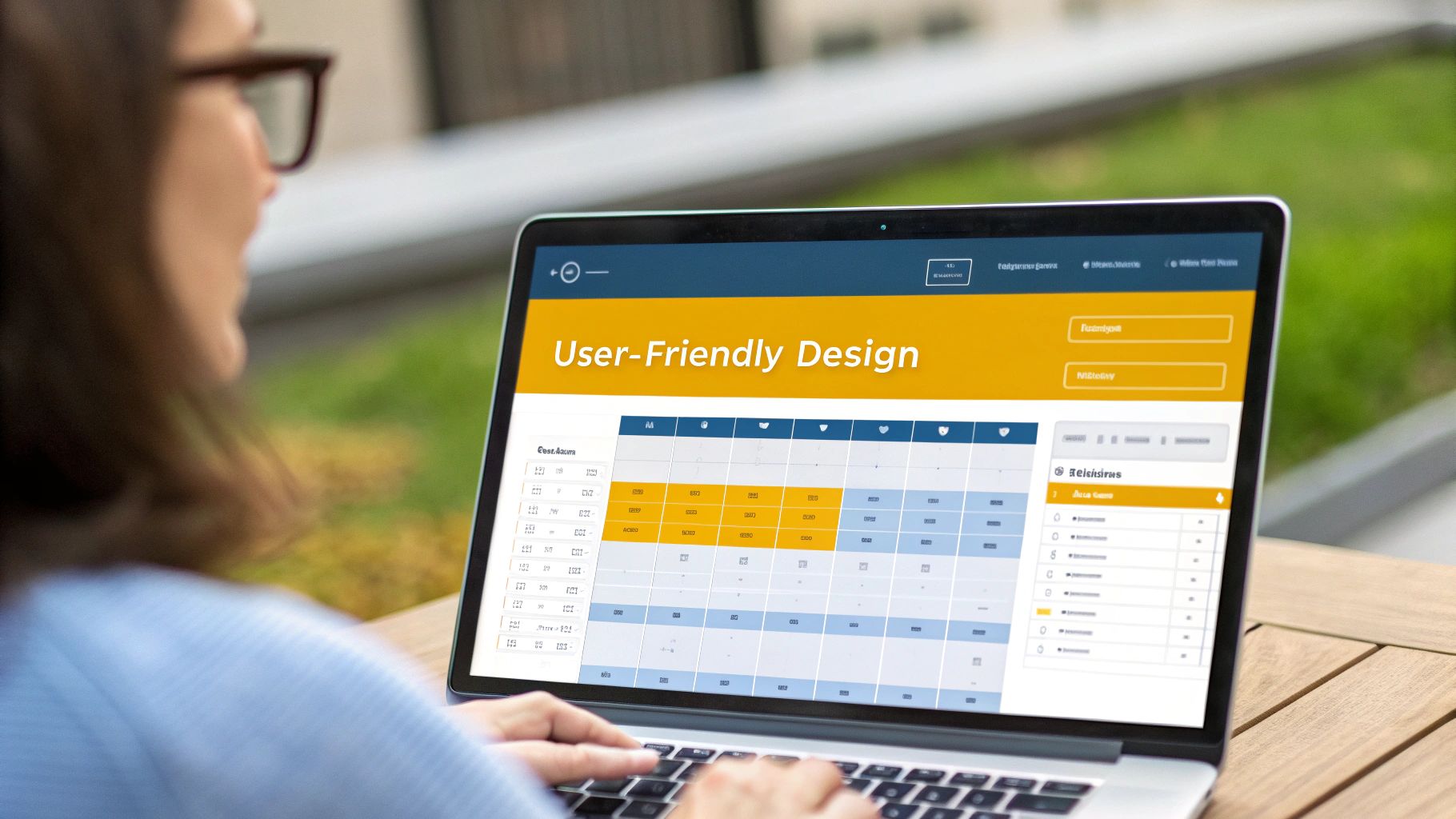From our resource library for organizational scheduling and management.
The Ultimate Guide to Staff Roster Programs: Transforming Modern Workforce Management

Understanding Modern Staff Roster Programs

Managing employee schedules has become increasingly complex for businesses of all sizes. Gone are the days when a simple spreadsheet could handle all scheduling needs. Modern organizations need tools that can handle everything from shift assignments to compliance tracking while keeping employees happy and engaged. That's why many companies are turning to advanced staff roster programs.
Key Features of a Modern Staff Roster Program
Today's roster programs pack powerful features that make life easier for both managers and employees. Here's what sets them apart:
- Smart Scheduling Tools: Built-in algorithms create schedules that account for employee availability, business needs, and staffing rules - saving hours of manual work
- Live Updates: Staff can mark their availability and request changes in real-time, helping managers quickly fill open shifts and maintain proper coverage
- Mobile-First Design: Employees check schedules, swap shifts, and request time off right from their phones, giving them more control over their work-life balance
- Built-in Compliance: The software tracks labor laws and regulations automatically, helping businesses avoid costly violations
- Data Insights: Clear reports show labor costs, overtime trends, and other key metrics that help optimize staffing decisions
The Shift From Traditional to Modern
Many businesses still rely on old-school scheduling methods. In fact, 50% of small businesses still use pen and paper to track schedules and attendance. You can learn more about how scheduling has evolved here: The Evolution of Employee Scheduling. But these manual methods waste time and lead to mistakes.
Take a restaurant manager who needs to adjust staffing based on how busy the dinner rush might be. With modern roster software, they can quickly update schedules using real data about customer patterns. This helps provide better service while keeping labor costs in check. The software handles the tedious work so managers can focus on running their business.
Benefits of Implementing a Staff Roster Program
Making the switch to modern scheduling software helps everyone in the organization:
- Less Paperwork: Managers spend less time on administrative tasks
- Better Legal Protection: Automated tracking helps prevent compliance issues
- Happier Employees: Staff members appreciate having more input into their schedules
Good roster software does more than just assign shifts - it helps build a stronger workplace. Want to learn more? Check out The Complete Guide to Modern Workforce Management. When businesses use these tools effectively, they create an environment where both managers and employees can thrive. This leads to better retention, higher productivity, and ultimately, better results for the company.
AI and Predictive Analytics in Staff Scheduling

Staff scheduling software has evolved far beyond basic digital calendars. The integration of Artificial Intelligence (AI) and predictive analytics now allows businesses to create smarter, more efficient schedules that benefit both employees and organizations. These tools help managers make better staffing decisions backed by data rather than guesswork.
Using Data to Forecast Staffing Needs
Traditional scheduling often relies on managers' past experiences and rough estimates, which can lead to having too many or too few staff members working at any given time. AI changes this by analyzing multiple data sources - from sales data to foot traffic patterns and even weather forecasts - to predict exactly how many employees you'll need. For instance, a coffee shop can use these insights to staff up before the morning rush or schedule extra baristas when rainy weather typically drives more customers inside.
Getting the Right People at the Right Time
Good scheduling isn't just about having enough people - it's about having the right mix of skills and experience for each shift. AI-powered tools excel at matching employee skills and availability with business needs while respecting individual preferences. They can automatically handle shift swaps and time-off requests, saving managers countless hours of administrative work. These systems learn from past schedules and outcomes to suggest improvements over time. Want to learn more about effective staff scheduling? Check out this guide on staff rostering fundamentals.
Finding the Sweet Spot Between AI and Human Touch
While AI brings powerful capabilities to scheduling, the human element remains essential. Managers need to review AI-generated schedules, handle special situations, and maintain personal connections with their teams. The best scheduling systems, like Acroroster, give managers smart tools while letting them stay in control. This combination helps create schedules that work well on paper and in practice. When technology and human judgment work together, the result is better schedules, happier employees, and more successful operations.
Creating Employee-Centric Scheduling Experiences
Modern staff roster programs are evolving to put employees first. Rather than just assigning shifts from the top down, these tools now enable true collaboration between managers and staff. When employees have more control over their schedules, they're happier at work and more likely to stay with the company long-term.
Preference-Based Scheduling and Mobile Shift Management
One of the most helpful features in today's scheduling tools is preference-based scheduling. Employees can indicate which shifts work best for their lives, and managers can factor these preferences into the schedule while ensuring business needs are met. Staff members also appreciate being able to manage their schedules right from their phones - viewing shifts, swapping with coworkers, and requesting time off takes just a few taps.
Take a hospital setting, for example. A nurse who needs specific weekends off for family care can input those preferences directly into the system. The staff roster program then works to accommodate this while creating a fair schedule for the whole team. This saves everyone time and reduces scheduling headaches.
Flexible Scheduling Policies
Good scheduling isn't just about the software - it's about giving employees meaningful choices. Options like flexible start and end times, compressed workweeks, and job sharing help staff balance work with their personal lives. While managers need to make sure all shifts are covered, being flexible with scheduling often leads to more engaged employees who stick around longer. Want to learn more? Check out this guide on effective employee rostering.
Measuring Employee Satisfaction
To know if your scheduling approach is working, you need to track results. Regular employee surveys, feedback sessions, and metrics like attendance and turnover rates can show you what's working and what needs adjustment. For additional insights, see this article on How to Master Lieu Time Off. The data helps ensure your staff roster program truly serves your team's needs.
Real-World Examples
Many organizations are finding creative ways to balance business requirements with employee preferences. Some hospitals use staff roster programs that let nurses bid on shifts based on seniority and personal choice, creating a fair and transparent process. Retail stores are adopting mobile apps that make shift swapping simple, giving staff more control over their schedules. These real examples show how putting employees first with scheduling leads to better results for everyone - more satisfied workers, lower turnover, and a stronger organization overall.
Implementing Your Staff Roster Program Successfully

Getting a new staff roster program up and running takes more than just picking good software. Success comes from carefully managing the change process and making sure everyone understands and supports the new system. Here's what you need to know about making the switch smoothly.
Transitioning From Legacy Systems
Moving away from your current scheduling system can feel daunting at first. I've found that starting with a clear plan makes all the difference. Begin by sitting down with key team members to understand their needs and concerns. Show them exactly how the new system will make their jobs easier through hands-on demos and Q&A sessions. Give staff plenty of time to practice with the software before it goes live, offering a mix of in-person training and self-paced learning resources.
Building a Strong Foundation for Success
A successful rollout needs three key pieces:
- A Clear Implementation Schedule: Map out specific goals, deadlines, and who's responsible for what. Think of this as your guide to keep everything moving forward smoothly.
- Support at Every Level: From managers to frontline workers, help everyone see how they'll benefit from the change. Focus on practical ways it will improve their daily work.
- Open Communication Lines: Keep information flowing throughout the process. Regular updates and easy ways to ask questions help prevent confusion and build confidence.
Consider starting with a small test group before rolling out company-wide. This lets you spot and fix any issues early on, while gathering helpful feedback to improve training for everyone else.
Training and Ongoing Support
Good training makes all the difference in adoption rates. Mix up your approach with different learning options - some people learn best through videos, others prefer hands-on practice, and many appreciate having written guides to reference later. Set up an easy way for staff to get help when they need it, whether that's through a dedicated support person or an online help center. When people know help is readily available, they're more likely to embrace the new system.
Risk Mitigation and Long-Term Success
Think ahead about potential roadblocks and have backup plans ready. Common challenges include technical glitches, staff resistance to change, and data transfer hiccups. Having solutions prepared helps keep things moving smoothly if issues come up. Remember that implementing your roster program isn't just a one-time project - it needs ongoing attention to stay effective. Check in regularly with users, look at how the system is being used, and make adjustments based on real feedback. Keep the focus on practical improvements that help your team work better together.
Measuring Success Through Data-Driven Insights
Creating an effective staff roster program requires more than just implementation - you need to track its performance and show real business value. By measuring the right metrics and analyzing the data, you can understand exactly how well your scheduling system is working and where it needs improvement.
Traditional KPIs and Beyond
The basic metrics tell part of the story: labor costs, overtime hours, and employee turnover. But modern scheduling tools give you much deeper insights. You can now monitor shift fill rates, time-to-fill open shifts, and even gauge employee satisfaction with schedules. These additional data points show the full impact of your scheduling approach on daily operations.
Smart organizations also connect scheduling data to their wider business metrics. They might look at how staffing levels affect sales during busy periods, or study whether schedule changes influence customer satisfaction scores. This helps prove the real value of the roster program and makes a strong case for further improvements. For more insights, check out The Ultimate Guide to Nurse Rostering Software.
Establishing Benchmarks and Tracking Progress
To measure real progress, you need clear standards to measure against. These could come from industry averages, your past performance, or goals set by your team. Regular comparison against these benchmarks shows you exactly how well you're doing and spots areas that need work.
For example, if you aim for a 95% shift fill rate but currently achieve 90%, you can see there's room for improvement. This kind of clear feedback helps you adjust your approach to reach your targets.
Communicating Success to Stakeholders
Getting ongoing support means showing clear results to decision makers. The key is presenting data in simple, visual formats like dashboards and reports that highlight how the program helps achieve business goals.
Here's a simple way to show progress to stakeholders:
| Metric | Benchmark | Current Performance | Change |
|---|---|---|---|
| Labor Costs as % of Revenue | 30% | 28% | -2% |
| Employee Turnover Rate | 20% | 15% | -5% |
| Shift Fill Rate | 95% | 92% | -3% |
This clear presentation helps everyone understand how the program is performing and what it's achieving. Regular updates build support for the program and show its ongoing value. The insights also help guide decisions about staffing, budgets, and operations, making your roster program a key tool for business success.
Future-Proofing Your Scheduling Strategy

Work patterns and employee needs keep shifting. Smart businesses know they need scheduling tools that can grow and adapt over time. Let's explore how to build a scheduling approach that stays effective for years to come.
Embracing Flexibility and Adaptability
Most employees now expect some control over when and where they work. A good scheduling system needs to support remote work, varied hours, and different work arrangements while keeping operations running smoothly. For instance, giving staff the ability to trade shifts through their phones helps them manage their time better while ensuring all positions stay covered.
Integrating with Emerging Technologies
Your scheduling system should work smoothly with other business tools. This means connecting to tools that analyze workforce data or help teams communicate. Picture this: when managers update the schedule, employees get instant notifications on their phones - no more missed messages or confusion about shift times.
Using Data to Make Better Decisions
Smart scheduling is all about using information effectively. Modern staff roster programs can spot patterns in your staffing needs and help predict busy periods. This means managers can plan ahead, avoid scheduling conflicts, and keep operations running efficiently. The right data helps you put the right people in the right places at the right times.
Putting Employee Experience First
Happy employees tend to stay longer and work better. Good scheduling systems let staff have a say in their schedules, mark their preferences, and communicate easily with managers. When people feel heard and respected, they're more likely to be satisfied with their jobs. This leads to better retention rates and a more stable workforce.
Always Looking to Improve
Creating great schedules isn't something you do once and forget about. It takes regular check-ins with your team, listening to feedback, and making adjustments as needed. Maybe you'll find new tools that could help, or discover better ways to handle certain shifts. The key is staying open to change and willing to make improvements.
Want to take your scheduling to the next level? Acroroster offers all the tools you need to create schedules that work for everyone. Visit us to learn more about how we can help your business run more smoothly.